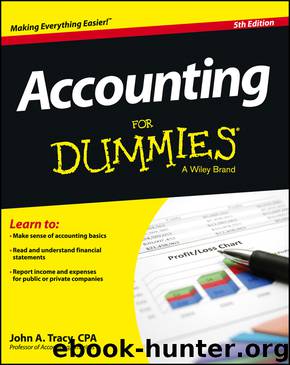Accounting For Dummies, 5th Edition by John A. Tracy CPA

Author:John A. Tracy, CPA
Language: eng
Format: epub
Publisher: John Wiley and Sons, Inc.
Published: 2013-02-24T16:00:00+00:00
* * *
Where profit goes in a corporation
Suppose that a private business earned $1.32 million net income for the year just ended and has issued 400,000 capital stock shares. Divide net income by the number of shares, and you come up with earnings per share of $3.30. Assume that the business paid $400,000 cash dividends during the year, or $1.00 per share. The retained earnings account thus increased $2.30 per share (earnings per share minus dividends per share). Although stockholders don’t have the cash to show for it, their investment is better off by $2.30 per share, which shows up in the balance sheet as an increase in the retained earnings account. They can hope that the business will use the cash provided from profit to increase future profit, which should lead to higher cash dividends.
Now, suppose the business is a public company that is 1,000 times larger. It earned $1.32 billion on its 400 million capital stock shares and distributed $400 million in cash dividends. You may think that the market value should increase $2.30 per share, because the business earned this much per share that it retained in the business and did not distribute to its shareholders. Your thinking is quite logical: Profit is an increase in the net assets of a business (assets less liabilities, which is also called net worth). The business is $2.30 per share “richer” at the end of the year than it was at the start of the year, due to the profit it earned and retained.
Yet it’s entirely possible that the market price of the stock shares actually decreased during the year. Market prices are governed by psychological, political, and economic factors that go beyond the information in the financial reports of a business. Financial statements are only one of the information sources that stock investors use in making their buy-and-sell decisions. Chapters 13 and 16 explain how stock investors use the information in financial reports.
Download
This site does not store any files on its server. We only index and link to content provided by other sites. Please contact the content providers to delete copyright contents if any and email us, we'll remove relevant links or contents immediately.
The Brazilian Economy since the Great Financial Crisis of 20072008 by Philip Arestis Carolina Troncoso Baltar & Daniela Magalhães Prates(116968)
International Integration of the Brazilian Economy by Elias C. Grivoyannis(86789)
The Art of Coaching by Elena Aguilar(52844)
Flexible Working by Dale Gemma;(23232)
How to Stop Living Paycheck to Paycheck by Avery Breyer(19604)
The Acquirer's Multiple: How the Billionaire Contrarians of Deep Value Beat the Market by Tobias Carlisle(12190)
Thinking, Fast and Slow by Kahneman Daniel(11988)
The Radium Girls by Kate Moore(11877)
The Art of Thinking Clearly by Rolf Dobelli(10150)
Hit Refresh by Satya Nadella(9001)
The Compound Effect by Darren Hardy(8742)
Tools of Titans by Timothy Ferriss(8163)
Atomic Habits: Tiny Changes, Remarkable Results by James Clear(8130)
Turbulence by E. J. Noyes(7903)
Change Your Questions, Change Your Life by Marilee Adams(7575)
A Court of Wings and Ruin by Sarah J. Maas(7569)
Nudge - Improving Decisions about Health, Wealth, and Happiness by Thaler Sunstein(7472)
How to Be a Bawse: A Guide to Conquering Life by Lilly Singh(7349)
Win Bigly by Scott Adams(7041)
